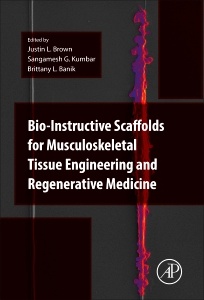Description
Bio-Instructive Scaffolds for Musculoskeletal Tissue Engineering and Regenerative Medicine
Authors: Brown Justin, Kum bar Sangamesh G., Banik Brittany
Language: English
Subjects for Bio-Instructive Scaffolds for Musculoskeletal Tissue...:
158.56 €
In Print (Delivery period: 14 days).
Add to cartSupport: Print on demand
Description
/li>Contents
/li>Biography
/li>Comment
/li>
Bio-Instructive Scaffolds for Musculoskeletal Tissue Engineering and Regenerative Medicine explores musculoskeletal tissue growth and development across populations, ranging from elite athletes to the elderly. The regeneration and reparation of musculoskeletal tissues present the unique challenges of requiring both the need to withstand distinct forces applied to the body and ability to support cell populations.
The book is separated into sections based on tissue type, including bone, cartilage, ligament and tendon, muscle, and musculoskeletal tissue interfaces. Within each tissue type, the chapters are subcategorized into strategies focused on cells, hydrogels, polymers, and other materials (i.e. ceramics and metals) utilized in musculoskeletal tissue engineering applications.
In each chapter, the relationships that exist amongst the strategy, stem cell differentiation and somatic cell specialization at the intracellular level are emphasized. Examples include intracellular signaling through growth factor delivery, geometry sensing of the surrounding network, and cell signaling that stems from altered population dynamics.
Part I: Introduction
Chapter 1: Bio-Instructive Cues in Scaffolds for Musculoskeletal Tissue Engineering and Regenerative Medicine
Chapter 2: Functionalizing With Bioactive Peptides to Generate Bio-Instructive Scaffolds
Part II: Bone
Chapter 3: Bio-Instructive Scaffolds for Bone Regeneration
Part III: Tendon/Ligament
Chapter 4: Bio-Instructive Scaffolds for Tendon/Ligament Regeneration
Part IV: Cartilage
Chapter 5: Bio-Instructive Scaffolds for Cartilage Regeneration
Part V: Muscle
Chapter 6: Ultrastructure and Biomechanics of Skeletal Muscle ECM: Implications in Tissue Regeneration
Chapter 7: Bio-Instructive Scaffolds for Muscle Regeneration: NonCrosslinked Polymers
Chapter 8: Bio-Instructive Scaffolds for Skeletal Muscle Regeneration: Conductive Materials
Part VI: Musculoskeletal Interfaces
Chapter 9: Bio-Instructive Scaffolds for Musculoskeletal Interfaces
Dr. Kumbar is an Assistant Professor in the Departments of Orthopaedic Surgery, Materials Science & Engineering and Biomedical Engineering at the University of Connecticut. His research is focused on synthesis and characterization of novel biomaterials for tissue engineering and drug delivery applications. These polymeric materials namely polysaccharides, polyphosphazenes, polyanhydrides, polyesters as well as blends of two or more of the polymeric materials and composites combining the polymeric materials with ceramics in the form of 3-dimentional porous structures will serve as scaffolds for variety of tissue engineering applications. Dr. Kumbar is an active member of Society for Biomaterials (SFB), Controlled Release Society (CRS), Materials Research Society (MRS) and Orthopaedic Research Society (ORS). Dr. Kumbar is serving as a reviewer for more than 25 journals in the field of biomaterials, drug delivery and tissue engineering. He has recently edited a book “Natural and Synthetic Biomedical Polymers Elsevier Science & Technology, 2014- ISBN: 978-0-12-396983-5. He is also on the Editorial Board of more than 7 journals in the area of his expertise including Journal of Biomedical Materials Research-Part B, Journal of Applied Polymer Science, and Journal of Biomedical Nanotech
- Presents a self-contained work for the field of musculoskeletal tissue engineering and regenerative medicine
- Focuses on how materials of structures can be designed to be resistant while promoting viable grafts
- Contains major tissue types that are covered with a strategy for each material and structure
These books may interest you

Musculoskeletal Tissue Engineering 222.81 €



